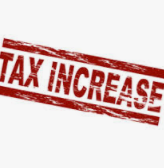
More than 50 tax provisions, including the tax rate schedules, and other tax changes are adjusted for inflation in 2016. Let’s take a look at the ones most likely to affect taxpayers like you.
The tax rate of 39.6 percent affects singles whose income exceeds $415,050 ($466,950 for married taxpayers filing a joint return), up from $413,200 and $464,850, respectively. The other marginal rates–10, 15, 25, 28, 33 and 35 percent–and related income tax thresholds–are found at IRS.gov.
The standard deduction remains at $6,300 for singles and married persons filing separate returns and $12,600 for married couples filing jointly. The standard deduction for heads of household rises to $9,300, up from $9,250.
The limitation for itemized deductions to be claimed on tax year 2016 returns of individuals begins with incomes of $259,400 or more ($311,300 for married couples filing jointly).
The personal exemption for tax year 2016 rises to $4,050, up from the 2015 exemption of $4,000. However, the exemption is subject to a phase-out that begins with adjusted gross incomes of $259,400 ($311,300 for married couples filing jointly). It phases out completely at $381,900 ($433,800 for married couples filing jointly.)
The Alternative Minimum Tax exemption amount for tax year 2016 is $53,900 and begins to phase out at $119,700 ($83,800, for married couples filing jointly for whom the exemption begins to phase out at $159,700). The 2015 exemption amount was $53,600 ($83,400 for married couples filing jointly). For tax year 2016, the 28 percent tax rate applies to taxpayers with taxable incomes above $186,300 ($93,150 for married individuals filing separately).
For 2016, the maximum Earned Income Credit amount is $6,269 for taxpayers filing jointly who have 3 or more qualifying children, up from a total of $6,242 for tax year 2015. The revenue procedure has a table providing maximum credit amounts for other categories, income thresholds and phase-outs.
Estates of decedents who die during 2016 have a basic exclusion amount of $5,450,000, up from a total of $5,430,000 for estates of decedents who died in 2015.
For 2016, the exclusion from tax on a gift to a spouse who is not a U.S. citizen is $148,000, up from $147,000 for 2015.
For 2016, the foreign earned income exclusion rises to $101,300, up from $100,800 in 2015.
The annual exclusion for gifts remains at $14,000 for 2016.
The annual dollar limit on employee contributions to employer-sponsored healthcare flexible spending arrangements (FSA) remains at $2,550.
Under the small business health care tax credit, the maximum credit is phased out based on the employer’s number of full-time equivalent employees in excess of 10 and the employer’s average annual wages in excess of $25,900 for tax year 2016, up from $25,800 for 2015.
Need help with tax planning in 2016? Help is just a phone call away!
ADVANCE PAYMENTS OF THE PREMIUM TAX CREDIT
When you enroll in coverage through the Marketplace during Open Season, which runs through Jan. 31, 2016, you can choose to have monthly advance credit payments sent directly to your insurer. If you get the benefit of advance credit payments in any amount, or if you plan to claim the premium tax credit, you must file a federal income tax return and use Form 8962.
Form 8962, Premium Tax Credit (PTC), reconciles the amount of advance credit payments made on your behalf with the amount of your actual premium tax credit. You must file an income tax return for this purpose even if you are otherwise not required to file a return.
Here are four things to know about advance payments of the premium tax credit:
If the premium tax credit computed on your return is more than the advance credit payments made on your behalf during the year, the difference will increase your refund or lower the amount of tax you owe. This will be reported in the ‘Payments’ section of Form 1040.
If the advance credit payments are more than the amount of the premium tax credit you are allowed, you will add all or a portion of the excess advance credit payments made on your behalf to your tax liability by entering it in the ‘Tax and Credits’ section of your tax return. This will result in either a smaller refund or a larger balance due.
If advance credit payments are made on behalf of you or an individual in your family, and you do not file a tax return, you will not be eligible for advance credit payments or cost-sharing reductions to help pay for your Marketplace health insurance coverage in future years.
The amount of excess advance credit payments that you are required to repay may be limited based on your household income and filing status.
If your household income is 400 percent or more of the applicable federal poverty line, you will have to repay all of the advance credit payments. Repayment limits by household income as a percentage of the federal poverty line are listed below.
REPAYMENT LIMITATION
If your household income is less than 200 percent of the Federal Poverty Line, the limitation amount is $300 for single filers and $600 for all other filing statuses.
If your household income is at least 200 percent, but less than 300 percent of the Federal Poverty Line the limitation amount is $750 for single filers and $1,500 for all other filing statuses.
If your household income is at least 300 percent, but less than 400 percent of the Federal Poverty Line the limitation amount is $1,250 for single filers and $2,500 for all other filing statuses.
If your household income is more than 400 percent of the Federal Poverty Line, there is no limitation amount for any filing status.
If you have any questions, don’t hesitate to call the office.
Go to top
ALES: INFORMATION REPORTING AND HEALTH COVERAGE
The Affordable Care Act requires applicable large employers (ALEs) to file information reporting returns with the IRS and employees. ALEs are generally those employers with 50 or more full-time employees, including full-time equivalent employees in the preceding calendar year.
The vast majority of employers are not ALEs and are not subject to this health care tax provision. However, those who are must use Form 1094-C, Transmittal of Employer-Provided Health Insurance Offer and Coverage Information Returns, and Form 1095-C, Employer-Provided Health Insurance Offer and Coverage, to report the information about offers of health coverage and enrollment in health coverage for their employees.
Here are eight things ALEs should know about the information returns they must file at the beginning of 2016.
1. Form 1095-C is used to report information about each employee who was a full-time employee of the ALE member for any month of the calendar year.
2. Form 1094-C must be used to report to the IRS summary information for each employer, and to transmit Forms 1095-C to the IRS.
3. ALEs file a separate Form 1095-C for each of its full-time employees, and a transmittal on Form 1094-C for all of the returns filed for a given calendar year.
4. Employers that offer employer-sponsored self-insured coverage use Form 1095-C to report information to the IRS and to employees about individuals who have minimum essential coverage under the employer plan.
5. The information reported on Form 1094-C, and Form 1095-C is used in determining whether an employer owes a payment under the employer shared responsibility provisions.
6. Form 1095-C is used by the IRS and the employee in determining the eligibility of the employee for the premium tax credit.
7. An ALE may satisfy this requirement by filing a substitute form, but the substitute form must include all of the information required on Form 1094-C and Form 1095-C and satisfy all form and content requirements as specified by the IRS.
8. Forms 1094-C and 1095-C, or a substitute form must be filed regardless of whether the ALE member offers coverage, or the employee enrolls in any coverage offered.
Questions?
If you have any questions regarding information reporting and health coverage, please call.
IRS ANNOUNCES STANDARD MILEAGE RATES IN 2016
Beginning on Jan. 1, 2016, the standard mileage rates for the use of a car, van, pickup or panel truck are:
54 cents per mile for business miles driven, down from 57.5 cents for 2015
19 cents per mile driven for medical or moving purposes, down from 23 cents for 2015
14 cents per mile driven in service of charitable organizations
The business mileage rate decreased 3.5 cents per mile and the medical, and moving expense rates decrease 4 cents per mile from the 2015 rates. The charitable rate is based on statute.
The standard mileage rate for business is based on an annual study of the fixed and variable costs of operating an automobile, including depreciation, insurance, repairs, tires, maintenance, gas and oil. The rate for medical and moving purposes is based on the variable costs, such as gas and oil. The charitable rate is set by law.
These optional standard mileage rates are used to calculate the deductible costs of operating an automobile for business, charitable, medical or moving purposes.
Taxpayers always have the option of claiming deductions based on the actual costs of using a vehicle rather than the standard mileage rates.
A taxpayer may not use the business standard mileage rate for a vehicle after using any depreciation method under the Modified Accelerated Cost Recovery System (MACRS) or after claiming a Section 179 deduction for that vehicle. In addition, the business standard mileage rate cannot be used for more than four vehicles used simultaneously. Call if you need additional information about these and other special rules.
In addition, basis reduction amounts for those choosing the business standard mileage rate, as well as the maximum standard automobile cost that may be used in computing an allowance under a fixed and variable rate plan and the maximum standard automobile cost that may be used in computing the allowance under a fixed and variable rate (FAVR) Plan were also announced by the IRS.
If you have any questions about standard mileage rates or which driving activities you should keep track of as tax year 2015 begins, don not hesitate to call the office.
Go to top
TAX DUE DATES FOR JANUARY 2016
DURING JANUARY
All employers – Give your employees their copies of Form W-2 for 2015 by February 1, 2016. If an employee agreed to receive Form W-2 electronically, post it on a website accessible to the employee and notify the employee of the posting by February 1.
All Businesses – Give annual information statements to recipients of certain payments you made during 2015. You can use the appropriate version of Form 1099 or other information return. Form 1099 can be issued electronically with the consent of the recipient.
JANUARY 11
Employees – who work for tips. If you received $20 or more in tips during December, report them to your employer. You can use Form 4070, Employee’s Report of Tips to Employer.
JANUARY 15
Employers – Social Security, Medicare, and withheld income tax. If the monthly deposit rule applies, deposit the tax for payments in December 2015.
Individuals – Make a payment of your estimated tax for 2015 if you did not pay your income tax for the year through withholding (or did not pay in enough tax that way). Use Form 1040-ES. This is the final installment date for 2015 estimated tax. However, you do not have to make this payment if you file your 2015 return (Form 1040) and pay any tax due by February 1, 2016.
Employers – Non-payroll Withholding. If the monthly deposit rule applies, deposit the tax for payments in December 2015.
Farmers and Fisherman – Pay your estimated tax for 2015 using Form 1040-ES. You have until April 18 to file your 2015 income tax return (Form 1040). If you do not pay your estimated tax by January 15, you must file your 2015 return and pay any tax due by March 1, 2016, to avoid an estimated tax penalty.
FEBRUARY 1
Employers – Federal unemployment tax. File Form 940 for 2015. If your undeposited tax is $500 or less, you can either pay it with your return or deposit it. If it is more than $500, you must deposit it. However, if you already deposited the tax for the year in full and on time, you have until February 10 to file the return.
File Form 943 to report social security and Medicare taxes and withheld income tax for 2015. Deposit or pay any undeposited tax under the accuracy of deposit rules. If your tax liability is less than $2,500, you can pay it in full with a timely filed return. If you deposited the tax for the year in full and on time, you have until February 10 to file the return.
Certain Small Employers – File Form 944 to report Social Security and Medicare taxes and withheld income tax for 2015. Deposit or pay any undeposited tax under the accuracy of deposit rules. If your tax liability is $2,500 or more from 2015 but less than $2,500 for the fourth quarter, deposit any undeposited tax or pay it in full with a timely filed return. If you deposited the tax for the year timely, properly, and in full, you have until February 10 to file the return.
Employers – Social Security, Medicare, and withheld income tax. File Form 941 for the fourth quarter of 2015. Deposit any undeposited tax. If your tax liability is less than $2,500, you can pay it in full with a timely filed return. If you deposited the tax for the quarter in full and on time, you have until February 10 to file the return.
Employers – Nonpayroll taxes. File Form 945 to report income tax withheld for 2015 on all nonpayroll items, including backup withholding and withholding on pensions, annuities, IRAs, gambling winnings, and payments of Indian gaming profits to tribal members. Deposit any undeposited tax. If your tax liability is less than $2,500, you can pay it in full with a timely filed return. If you deposited the tax for the year in full and on time, you have until February 10 to file the return.
Payers of Gambling Winnings – If you either paid reportable gambling winnings or withheld income tax from gambling winnings, give the winners their copies of Form W-2G.
Employers – Give your employees their copies of Form W-2 for 2015 by February 1, 2016. If an employee agreed to receive Form W-2 electronically, post it on a website accessible to the employee and notify the employee by February 1, 2016.
Businesses – Give annual information statements to recipients of certain payments made during 2015. You can use the appropriate version of Form 1099 or other information return. Form 1099 can be issued electronically with the consent of the recipient. This due date only applies to certain types of payments.
Individuals – who must make estimated tax payments. If you did not pay your last installment of estimated tax by January 15, you may choose (but are not required) to file your income tax return (Form 1040) for 2015 by February 1. Filing your return and paying any tax due by February 1, 2016, prevents any penalty for late payment of the last installment. If you cannot file and pay your tax by February 1, file and pay your tax by April 18.


















Recent Comments